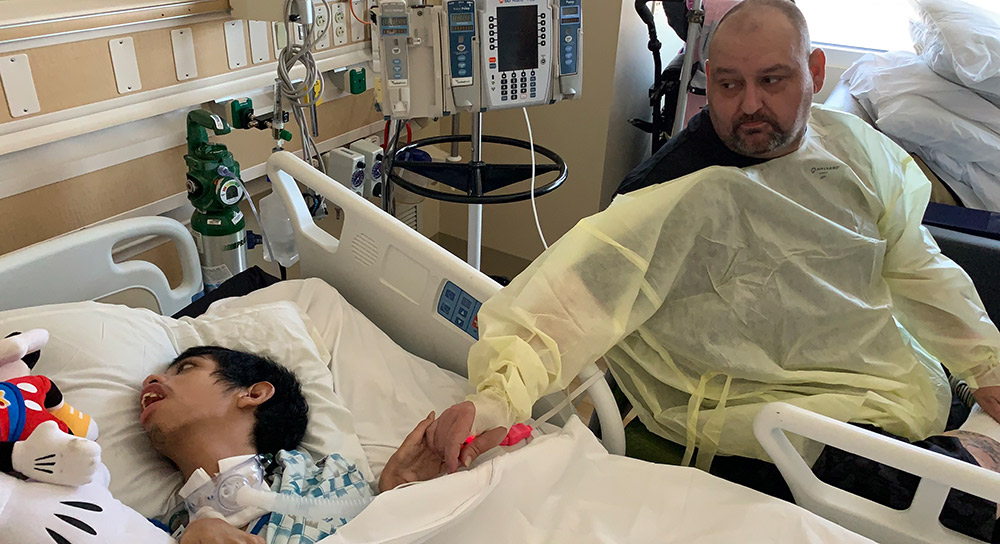Seventeen-year-old Marcus Weir traveled with his father Mark Weir out of his home state of California in December 2021. Two days after he returned, Marcus, who has a disability and is nonverbal, developed a bad cough. The next day he was extremely weak and non-responsive.
“So I called 9-1-1,” Mark said. Marcus was immediately transported to Community Regional Medical Center in downtown Fresno and admitted to the pediatric intensive care unit (PICU).
 “He came in with COVID-19 pneumonia and had … an extensive medical history,” explained Chris Prince, clinical coordinator for Pediatrics Respiratory Care at Community Regional. Because Marcus has a mobility disability as well as other co-existing conditions, he was considered to be at very high risk.
“He came in with COVID-19 pneumonia and had … an extensive medical history,” explained Chris Prince, clinical coordinator for Pediatrics Respiratory Care at Community Regional. Because Marcus has a mobility disability as well as other co-existing conditions, he was considered to be at very high risk.
Marcus was admitted to the PICU and put on a mechanical ventilator to breathe for him.
The medical team at Community Regional knew Marcus and his father faced a tough road ahead — Marcus was very weak and he was extremely sick.
“They told me that if he did live, it would be a miracle,” said Mark. “If he lived two days, it would be a miracle. If he lived three days, he might have a fighting chance.”
Pre-existing conditions make it harder for the body to fight COVID-19
The Centers for Disease Control and Prevention (CDC) says age is the strongest risk factor for severe COVID-19 outcomes, but patients like Marcus — with certain underlying medical conditions — are also at high risk from the disease.
In fact, the more underlying conditions a person has, the higher the risk for severe COVID-19 outcomes, according to the CDC.
“With any patient that has … pre-existing conditions, it’s just much rougher. (Marcus) had a really long road ahead of him,” said Prince.
The CDC website lists the following as preexisting or underlying conditions that make recovery more difficult for COVID-19 patients:
Asthma
Cancer
Chronic liver diseases
Cystic fibrosis
Type 1 and Type 2 diabetes
Disabilities including attention-deficit/hyperactivity disorder (ADHD) and cerebral palsy
Heart conditions such as heart failure or coronary artery disease
Mental health disorders like schizophrenia
Neurologic conditions like dementia
Tuberculosis
Returning to the PICU for more life-saving care
With the mechanical ventilator breathing for him, Marcus’s condition gradually got better and his oxygen levels improved. The medical team was able to wean him off the ventilator and pull out the breathing tube.
He was moved to the hospital’s pediatric floor where a respiratory therapist worked with him to ensure he would continue to make progress.
But there was another setback. “He ended up coming back to the PICU, and at that point they decided they needed to put a feeding tube in and put a tracheostomy breathing tube in his neck,” said Prince.
Taking a “complete care” approach
Marcus was still very weak and would need assistance at home, so the team trained Marcus’s dad to care for his son.
“Because (Marcus) doesn’t move a lot on his own, he is dependent on people to take care of him,” said Dr. Victor Vargas, Pediatric Intensive Care, Community Regional. “He got COVID-19 and his lungs were affected but also his heart and his blood pressure … He will have to have more support than he had in the past.”
That support was performed by hospital staff but they knew it would need to be continued at home, too. The respiratory therapists working with Marcus showed Mark how to suction fluids out of his lungs and change out the tracheostomy tube so he would be ready to go home.
Finally, a very happy ending for patient and dad
With Marcus on the mend and Mark fully trained on how to help him at home, Marcus was finally ready to leave the hospital after three months of intensive care and plenty of ups and downs.
Mark was thrilled to have his son come home. “I mean it’s the happiest day of my life. Like, we are going to go home; I can only be grateful and thankful to everybody that has had a hand in my son’s recovery,” Mark said when his son was discharged from the hospital.
It was a happy ending thanks to the life-saving care Marcus received from the time he arrived at Community Regional until he was able to go home. “If the emergency team had not acted fast and the father had not identified this as fast as he did, the patient could have died,” said Dr. Vargas.
The hospital and team received glowing reviews from Mark as well: “I recommend, if you guys are in this area or even if not in this area, come here. They save lives.”


.jpg?language=en-US)


